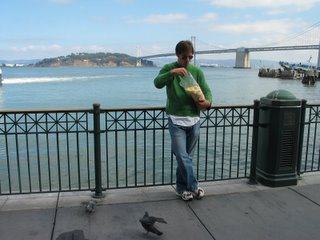Varanasi: Down by the River


Greetings from Varanasi, City of Shiva, the holiest of Hindu holy sights, the oldest consistently inhabited city in the world, and the only place I've ever seen a cow walk down stairs, stop to take a dump, then walk down more stairs.
The scene here is all about the Ganges River (or, the "Ganga"). Hindus believe that a bath in its holy waters will cleanse one completely of one's sins, and that cremation along its banks guarantees passage to nirvana. Meanwhile, scientists believe the water to be so polluted from factory runoff, assorted garbage, and, well, corpses, that they've classified it as being "septic", meaning it contains no dissolved oxygen (Science majors welcome to chime in on why that's bad).
So I've been happy to watch from the wings: the bathers, the fishermen, people doing their laundry, people brushing their teeth, etc. The riverfront is divided into a series of "ghats", or entry points, each overlooked by a decaying, fortress-like building with stairs leading down to the Ganga. Spending most of my time just strolling through the ghats, observing, dodging the offers of boat men and little girls selling flowers. Also, the place is crawling with animals: the aforementioned cows, which are holy to Hindus, as wells as goats, dogs, and monkeys.
One ghat that has held my attention extensively was called Harishchandra. It is one of the two main cremation ghats. Pyre after pyre goes up for public viewing. "Sixty or seventy per day, maximum one fifty," said Raj, a
 seventeen year old son of the ghat's owner, who was kind enough to explain nearly every part of the cremation ceremony. It starts with the bringing of the deceased to Varanasi no more than three days after death. A pyre is then arranged with wood of varying qualities. Sandal wood can fetch a price of 150 Rupees per kilo, which, for a 300kg cremation like the one I saw, would cost a hefty $1200. Poorer families must use cheaper wood and less of it, resulting in a slower and sometimes incomplete burning, with feet and fingers turning up in the river later on. Most everyone is welcome to cremation at Harishchandra Ghat, Raj explained, excluding (1) pregnant women, (2) women with young children, (3) victims of snake bite, (4) victims of leprosy, and (5) Sadhus (holy men who are given to the ganga unburned). The photo here of the wood is the only one I have of the cremation ghats, as it is not allowed to photograph the ceremonies.
seventeen year old son of the ghat's owner, who was kind enough to explain nearly every part of the cremation ceremony. It starts with the bringing of the deceased to Varanasi no more than three days after death. A pyre is then arranged with wood of varying qualities. Sandal wood can fetch a price of 150 Rupees per kilo, which, for a 300kg cremation like the one I saw, would cost a hefty $1200. Poorer families must use cheaper wood and less of it, resulting in a slower and sometimes incomplete burning, with feet and fingers turning up in the river later on. Most everyone is welcome to cremation at Harishchandra Ghat, Raj explained, excluding (1) pregnant women, (2) women with young children, (3) victims of snake bite, (4) victims of leprosy, and (5) Sadhus (holy men who are given to the ganga unburned). The photo here of the wood is the only one I have of the cremation ghats, as it is not allowed to photograph the ceremonies.Would love to stay longer, grow dreadlocks and wear flowing, white robes, like the many westerners who practically live here. But it's time to ramble on!



4 Comments:
The varanasi post is top-notch. But I demand an introduction on the famous blog! See you in a week or so.
rk
Start the first day by drinking one drop of Ganges water, then double it every day. After a month, you'll have consumed about 23 thousand gallons - and will be so used to it that you won't have to worry about gastronome-shredding nasties any more!!!!11
Jeff
Would have done, Jeff, but they kept putting a one Ruppee coin in my Nalgene bottle! Now I'm host to an autonomous nation of parasites.
BT:
Oh, but I miss ol' So-Ko. Luckily there are Koreans all over this country, and I'm able to through out the odd "Mashikatuhsehyo" at restaurants. If only I had a chamchi kimbap in front of me right now. I suspect finding the notepad would be step one.
Post a Comment
<< Home